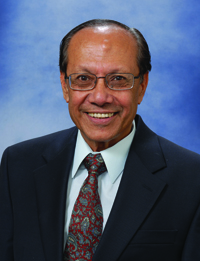
From maintaining a desired temperature in a home to keeping an unmanned aircraft on a steady course, proportional-integral-derivative (PID) controllers play a critical role in the operation, regulation and stability of control systems.
For more than 20 years, Dr. Shankar Bhattacharyya, the Robert M. Kennedy '26 Professor II in the Department of Electrical and Computer Engineering at Texas A&M University, has dedicated his time to the research and advancement of PID controllers. A pioneer in the field, he recently published his ninth book titled “Analytical Design of PID Controllers” in collaboration with Ph.D. student Sangjin Han and former Ph.D. student Ivan Díaz-Rodríguez.
“All nine books have been written while I've been at Texas A&M and all are in collaboration with colleagues here or my Ph.D. students,” said Bhattacharyya. “I feel privileged to have had Ph.D. students with whom I can do this kind of research that can get into a monograph. It's good for them, it's good for me, it's good for Texas A&M.”
With a myriad of real-world applications, PID controllers make it possible for desired parameters to be maintained in a feedback-control system.
Bhattacharyya used a household thermostat as an example. He said when a person wants the temperature in their room to be 70 degrees, he or she goes to the thermostat and sets it. Regardless of how many people are in that room or the weather outdoors, the system keeps the temperature at 70 degrees. This is because of the PID controller – a mechanism that calculates the temperature difference between the room and entered parameters and sends a signal to either kick on the heater or air conditioner to correct it.
“The same thing works whether you're trying to control the flow of fluid level in a tank, control the pressure in a chemical reactor or keep an airplane flying at a fixed angle, despite wind and disturbances,” said Bhattacharyya. “(PID controllers are) really the bread and butter of control engineering.”
Since 1997, Bhattacharyya has been investigating how to best design such technology in order to achieve the desired specifications based on two key measurements: robustness and resiliency.
Robustness and resilience in a control system means that, regardless of changes in parameters and uncertainties in the environment, the PID controller will still carry out its programmed orders.
Driven by these two key concepts, Bhattacharyya and his team have taken groundbreaking steps in applying a multi-objective design to PID controllers. This allows a simplistic three-option controller to successfully satisfy multiple system requirements simultaneously.
“It was our group that showed that a lot of the prevailing designs were fragile because they were high-order controllers,” said Bhattacharyya. “Instead of three parameters they had 20 or 25. And you might think that would do better because there are more things to play with. But actually, (the controller) becomes nonresilient because when controllers are too complicated, there are too many ways it can fail.”
With that in mind, Bhattacharyya and his team have focused on bolstering and enhancing simpler controllers, developing them through the use of rational computer-aided design and mathematically rigorous models and theories that are both elegant and practical. In doing so, they have not only optimized the original designs, but created a novel controller model to be implemented into the standard control systems utilized in all aspects of engineering and industry.
“PID controllers are so widely used that, if we make any progress, it impacts things like chemical, electrical, mechanical and aerospace engineering, driverless cars, unmanned aerial vehicles, smart grids, and more. A few years down the road it could be everywhere. It’s exciting that it impacts so many fields,” said Bhattacharyya.